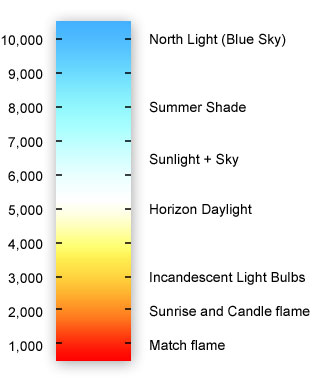The Short Version
If you’re not concerned with the technical jibber-jabber and just want to know what kind of light bulbs to get for your studio, here are the basics:
Color Temperature
Measured in Kelvins or K. 5000K will give you a nice white light.
Brightness
For a medium sized room, a total of 7000-8000 lumens is plenty. With a compact fluorescent bulb (not incandescent), that is usually about 110-125 Watts.
CRI Rating
The higher the better. Anything over 80 CRI is good.
Type
Go with compact fluorescent (CFL)
topbulb.com and 1000Bulbs.com are great suppliers of bulbs. You can get the bulbs specified above from them. They have a large selection of CFL’s and the pricing is very competitive. When choosing a bulb, make sure that you keep in mind the things I listed above.
And now for the technical stuff…
Color Temperature
The color temperature of the light bulb is extremely important. The color of the light that illuminates the painting and the palette changes the visible hue, value and chroma of the paint. Painting with a standard incandescent light bulb is like looking through a yellow filter. It shifts all the paint colors towards yellow. Scientifically, color temperature is commonly measured using the Kelvin scale.
Kelvin Scale
The color temperature of light is measured by comparing it to the color emitted by a black-body radiator heated to a specific temperature. A black-body radiator is a perfect emitter and absorber of radiation that emits a different color when heated to different temperatures. For example when carbon is heated to 10,000 degrees Kelvin it emits a blue color. When it is heated to 1800 degrees Kelvin, it emits a red color. This red color is equivalent to the color of candlelight. Thus, candlelight is assigned a color temperature of 1800K.

6500K is commonly accepted as the purest white light. It is equivalent to sunlight passing through a cloud which scatters the wavelengths to make white light. Some consider 6500K to have a slightly bluish hue. I prefer to paint under a 5000K bulbbecause it’s still white, but a bit closer to the yellow bulbs usually used in galleries.A north lit studio is popular among many artists, but I think with today’s technology supplementing the north light with some artificial light is better. North light is cooler, about 10,000K, and odds are your gallery won’t be lighting your artwork with such a cool bulb. Transferring a painting from a room lit by north light to a room light by incandescent light changes its colors dramatically.
If you’re painting in a room with south facing windows, i recommend closing those windows and adding artificial light (even though the color temperature of sun + sky is a nice white) because you don’t want any direct sunlight. I explain more of this in How to Setup a Painting Studio.
Brightness
The amount of light emitted is measured in lumens. For example a candle emits 12 lumens and a 32 Watt Compact Fluorescent bulb emits 2000 lumens. CFL bulbs are much more efficient in light output than incandescent bulbs. A 42 Watt CFL is equivalent to a 200 Watt Incandescent bulb.
For a medium sized room, a total of 7000-8000 lumens is plenty. With a CFL, that is usually about 110-125 Watts. It might be a good idea to get 2 or 3 bulbs totalling 7000 lumens and spread them around.
CRI
The Color Rendering Index measures how much of an effect the light has on the perceived color of an object. The scale ranges from 1 to 100. A higher rating makes colors look natural and vibrant while a low rating can completely change the hue of objects. A high CRI alone does not mean colors will be accurate if the color temperature is extreme. Incandescent bulbs for example have a perfect CRI of 100, but the extreme yellow light will shift the colors.
When buying compact fluorescent bulbs look for a bulb with an 80 CRI value or higher.
Type

Incandescent Bulbs
Incandescent bulbs are too yellow and use up a lot of energy.

Compact Fluorescent Lamps (CFL)
Compact fluorescent bulbs have many advantages. They come in a large range of color temperatures, they use less energy, they are brighter, and last longer. These bulbs are eco-friendly and you end up saving money in energy costs. Their only disadvantage is they take a few minutes to fully light up, but the benefits are worth it.
To me, the choice is obvious. Compact Fluorescnt is cheaper, longer lasting, brighter, and has better color control. If you haven’t made the switch yet, I’ve done some research and topbulb.com and 1000Bulbs.com are great suppliers of all kinds of bulbs including CFLs.
Compatibility
Some sockets don’t support bulbs over a certain wattage. Double check to make sure the bulb you choose is compatible with the socket. The great thing about Compact Fluorescent Bulbs (CFL) is that they have very low wattage but are very bright. They are extremely energy efficient. A 42W CFL is as bright as a 200W Incandescent bulb.
Light bulbs also come in a variety of screw in and plug in bases. Make sure to get the right kind for your socket.